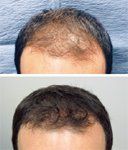- General Dermatology
- Eczema
- Chronic Hand Eczema
- Alopecia
- Aesthetics
- Vitiligo
- COVID-19
- Actinic Keratosis
- Precision Medicine and Biologics
- Rare Disease
- Wound Care
- Rosacea
- Psoriasis
- Psoriatic Arthritis
- Atopic Dermatitis
- Melasma
- NP and PA
- Skin Cancer
- Hidradenitis Suppurativa
- Drug Watch
- Pigmentary Disorders
- Acne
- Pediatric Dermatology
- Practice Management
- Prurigo Nodularis
Article
Cloning expected to represent future of hair transplantation
Cloning will represent a major advance in hair transplantation when it is ready for prime time. It remains elusive for now, but new clinical therapies - along with older standbys - are helping hair loss patients in the meantime, according to a leading specialist in hair transplantation.

Key Points
New Orleans - Cloning will represent a major advance in hair transplantation when it is ready for prime time. It remains elusive for now, but new clinical therapies - along with older standbys - are helping hair loss patients in the meantime, according to a leading specialist in hair transplantation.
One of the factors limiting hair transplantation is donor density. Individuals without good donor density can be less-than-ideal candidates for hair transplantation, notes Nicole Rogers, M.D., F.A.A.D., dermatologist and hair transplant surgeon and clinical professor, Tulane University, New Orleans. The potential for cloning leaves physicians hopeful for now.
"That would be the Holy Grail," Dr. Rogers says. "It would be great if we could harvest a single hair from the back (of the head) and create thousands of copycat hairs from that. There is significant research ongoing in that area, but we are not there yet. It's still going to be a while before it is ready for Food and Drug Administration approval."
Combination approach
"There are other variables that need to be investigated," Dr. Rogers says.
When patients present with a condition such as central centrifugal cicatricial alopecia (CCCA), Dr. Rogers may prescribe therapy such as doxycycline or intralesional steroids to control inflammation that is present, and then focus on hair transplantation. For male pattern hair loss, doctors can use medical therapy such as finasteride as an adjunct to hair transplantation.
"We (transplant surgeons) have found it is a wonderful complement to the procedure," Dr. Rogers says. "We can start patients when they are just noticing hair loss, so they can hold on to what they have and regrow a good amount of hair. In conjunction with surgery, finasteride can even reduce the number of procedures that a patient needs."
Dr. Rogers's practice in younger male patients is to prescribe medical therapy for about six to 12 months, and then evaluate whether the patient would still like to undergo transplantation.
"Medication is a good option, because we can't predict their hair loss," she says.
New advances

"Still, it is operator-dependent in terms of how the hairs are placed in the frontal area and what the final outcome is," Dr. Rogers says. "With this device, a prerequisite to success and a very natural result is its use by an experienced hair transplant surgeon."





